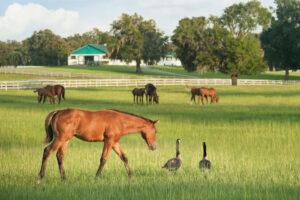Botulism Alert!
It was a grim sight. My wife’s handsome young National Show Horse gelding lay writhing on the ground, unable to rise. He appeared to be in the grip of partial paralysis that allowed movement of the front legs, but not the rear. We immediately
- Topics: Article, Botulism & Shaker Foal
It was a grim sight. My wife’s handsome young National Show Horse gelding lay writhing on the ground, unable to rise. He appeared to be in the grip of partial paralysis that allowed movement of the front legs, but not the rear. We immediately called for a veterinarian, then attempted to assist the gelding in rising. We couldn’t do it. He had no control over his rear end.
First one veterinarian, then another, from our local equine clinic were soon on the scene. Fluids were administered to battle signs of dehydration. And, if memory serves correctly, some antibiotics also might have been given. It was raining at the time, so we erected a makeshift tent with plastic tarps to keep the young gelding dry during the night. The dawn of another day brought no improvement in the horse’s condition. Instead, it appeared that the paralysis was spreading.
It was time to admit that we were fighting a losing battle and the gelding was humanely put down.
We were living in Kentucky at this time, so we had the horse’s body shipped to the diagnostic laboratory at the University of Kentucky in Lexington. The results of the necropsy were not long in coming
Create a free account with TheHorse.com to view this content.
TheHorse.com is home to thousands of free articles about horse health care. In order to access some of our exclusive free content, you must be signed into TheHorse.com.
Start your free account today!
Already have an account?
and continue reading.

Related Articles
Stay on top of the most recent Horse Health news with
















